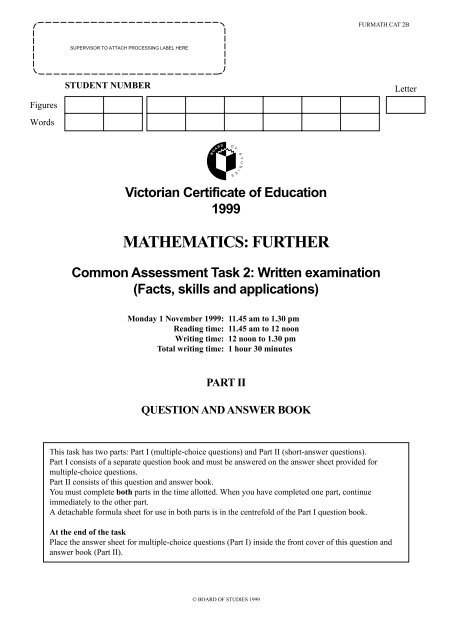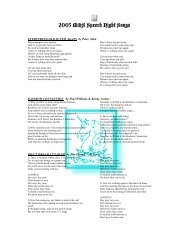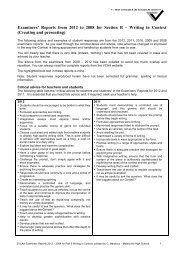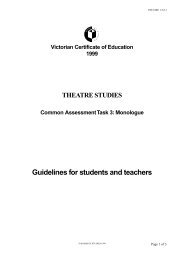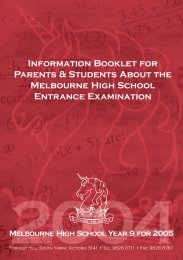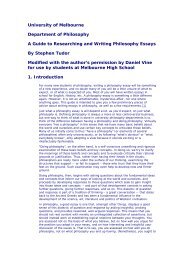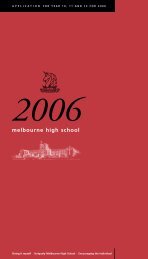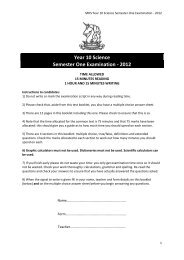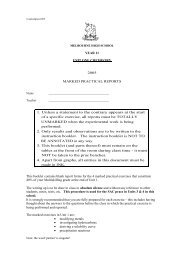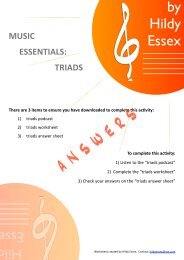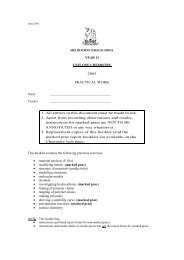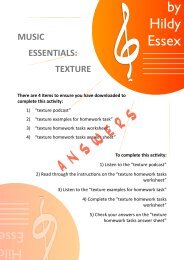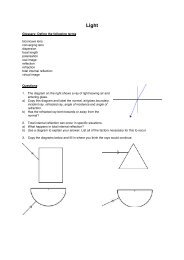Part II consists of a separate question and answer book.
Part II consists of a separate question and answer book.
Part II consists of a separate question and answer book.
- No tags were found...
Create successful ePaper yourself
Turn your PDF publications into a flip-book with our unique Google optimized e-Paper software.
TD1 FURMATH CAT 2BSUPERVISOR TO ATTACH PROCESSING LABEL HEREFiguresWordsSTUDENT NUMBERLetterB O A R DOFSUIESVictorian Certificate <strong>of</strong> Education1999MATHEMATICS: FURTHERCommon Assessment Task 2: Written examination(Facts, skills <strong>and</strong> applications)Monday 1 November 1999: 11.45 am to 1.30 pmReading time: 11.45 am to 12 noonWriting time: 12 noon to 1.30 pmTotal writing time: 1 hour 30 minutesPART <strong>II</strong>QUESTION AND ANSWER BOOKThis task has two parts: <strong>Part</strong> I (multiple-choice <strong>question</strong>s) <strong>and</strong> <strong>Part</strong> <strong>II</strong> (short-<strong>answer</strong> <strong>question</strong>s).<strong>Part</strong> I <strong>consists</strong> <strong>of</strong> a <strong>separate</strong> <strong>question</strong> <strong>book</strong> <strong>and</strong> must be <strong>answer</strong>ed on the <strong>answer</strong> sheet provided formultiple-choice <strong>question</strong>s.<strong>Part</strong> <strong>II</strong> <strong>consists</strong> <strong>of</strong> this <strong>question</strong> <strong>and</strong> <strong>answer</strong> <strong>book</strong>.You must complete both parts in the time allotted. When you have completed one part, continueimmediately to the other part.A detachable formula sheet for use in both parts is in the centrefold <strong>of</strong> the <strong>Part</strong> I <strong>question</strong> <strong>book</strong>.At the end <strong>of</strong> the taskPlace the <strong>answer</strong> sheet for multiple-choice <strong>question</strong>s (<strong>Part</strong> I) inside the front cover <strong>of</strong> this <strong>question</strong> <strong>and</strong><strong>answer</strong> <strong>book</strong> (<strong>Part</strong> <strong>II</strong>).© BOARD OF STUDIES 1999
FURMATH CAT 2B 2Structure <strong>of</strong> <strong>book</strong>Number <strong>of</strong><strong>question</strong>sNumber <strong>of</strong> <strong>question</strong>sto be <strong>answer</strong>ed3 3Directions to studentsMaterialsQuestion <strong>and</strong> <strong>answer</strong> <strong>book</strong> <strong>of</strong> 5 pages.You may bring to the CAT up to four pages (two A4 sheets) <strong>of</strong> pre-written notes.You may use an approved scientific <strong>and</strong>/or graphics calculator, ruler, protractor, set-square <strong>and</strong> aids forcurve-sketching.The taskDetach the formula sheet from the centre <strong>of</strong> the <strong>Part</strong> I <strong>book</strong> during reading time.Ensure that you write your student number in the space provided on the cover <strong>of</strong> this <strong>book</strong>. Answer all<strong>question</strong>s.The marks allotted to each <strong>question</strong> are indicated at the end <strong>of</strong> the <strong>question</strong>.There is a total <strong>of</strong> 10 marks available.␣You need not give numerical <strong>answer</strong>s as decimals unless instructed to do so. Alternative forms mayinvolve, for example, π, e, surds or fractions.Unless otherwise indicated, the diagrams in this <strong>book</strong> are not drawn to scale.All written responses should be in English.At the end <strong>of</strong> the taskPlace the <strong>answer</strong> sheet for multiple-choice <strong>question</strong>s (<strong>Part</strong> I) inside the front cover <strong>of</strong> this <strong>question</strong> <strong>and</strong><strong>answer</strong> <strong>book</strong> (<strong>Part</strong> <strong>II</strong>).
3 FURMATH CAT 2BSpecific instructions for studentsThere are three short-<strong>answer</strong> <strong>question</strong>s.Answer all parts <strong>of</strong> the <strong>question</strong>s in the spaces provided in this <strong>question</strong> <strong>and</strong> <strong>answer</strong> <strong>book</strong>.The table below shows the monthly rainfall (in millimetres) <strong>and</strong> the number <strong>of</strong> days on which it rained eachmonth for a Victorian rural city in 1998.Table 1: Monthly rainfall data for 1998Jan Feb Mar Apr May June July Aug Sept Oct Nov DecRainfall (mm) 28 31 33 41 53 65 64 56 47 48 34 26Number <strong>of</strong> rain days 4 5 3 6 9 11 14 12 9 8 6 5Question 1a. Complete the following table by classifying each <strong>of</strong> the variables in the table as numerical or categorical.VariableType <strong>of</strong> dataMonthRainfall (mm)numericalNumber <strong>of</strong> rain days2 marksb. Use the information in Table 1 to determine the percentage <strong>of</strong> months in 1998 which had more than 10rain days. Write your <strong>answer</strong> in the space provided.percentage =1 markc. Using the data in Table 1, calculate the st<strong>and</strong>ard deviation <strong>of</strong> the number <strong>of</strong> rain days. Write your <strong>answer</strong>correct to two decimal places in the space provided.st<strong>and</strong>ard deviation =2 marksTotal 5 marksTURN OVER
FURMATH CAT 2B 4The following scatterplot was constructed from the data in Table 1 to investigate the relationship betweenmonthly rainfall <strong>and</strong> the number <strong>of</strong> days it rains each month.706050rainfall(mm)4030201000 5 10 15number <strong>of</strong> rain daysQuestion 2a. Plot the point that represents the data for December on the scatterplot.1 markb. The value <strong>of</strong> Pearson’s product moment correlation coefficient, found from the data in Table 1, isr = 0.9308, correct to four decimal places. What is the value <strong>of</strong> the coefficient <strong>of</strong> determination, correct tothree decimal places?1 markc. The key assumption made about the nature <strong>of</strong> the relationship between monthly rainfall <strong>and</strong> the number <strong>of</strong>rain days, when calculating Pearson’s product moment correlation coefficient, is that the relationship is1 markTotal 3 marks
5 FURMATH CAT 2BWhen a least squares regression line is fitted to the data in Table 1, its equation is found to berainfall = 15.2 + 3.7 × number <strong>of</strong> rain days.Question 3a. Complete the following sentence by filling in the box.From the regression equation we can conclude that monthly rainfall increases on average bymillimetres for each extra day it rains in the month.1 markb. Use the regression equation to predict the rainfall (in millimetres) <strong>of</strong> a month in which it rains for 10 days.rainfall = mm1 markTotal 2 marksEND OF PART <strong>II</strong> QUESTION AND ANSWER BOOK


